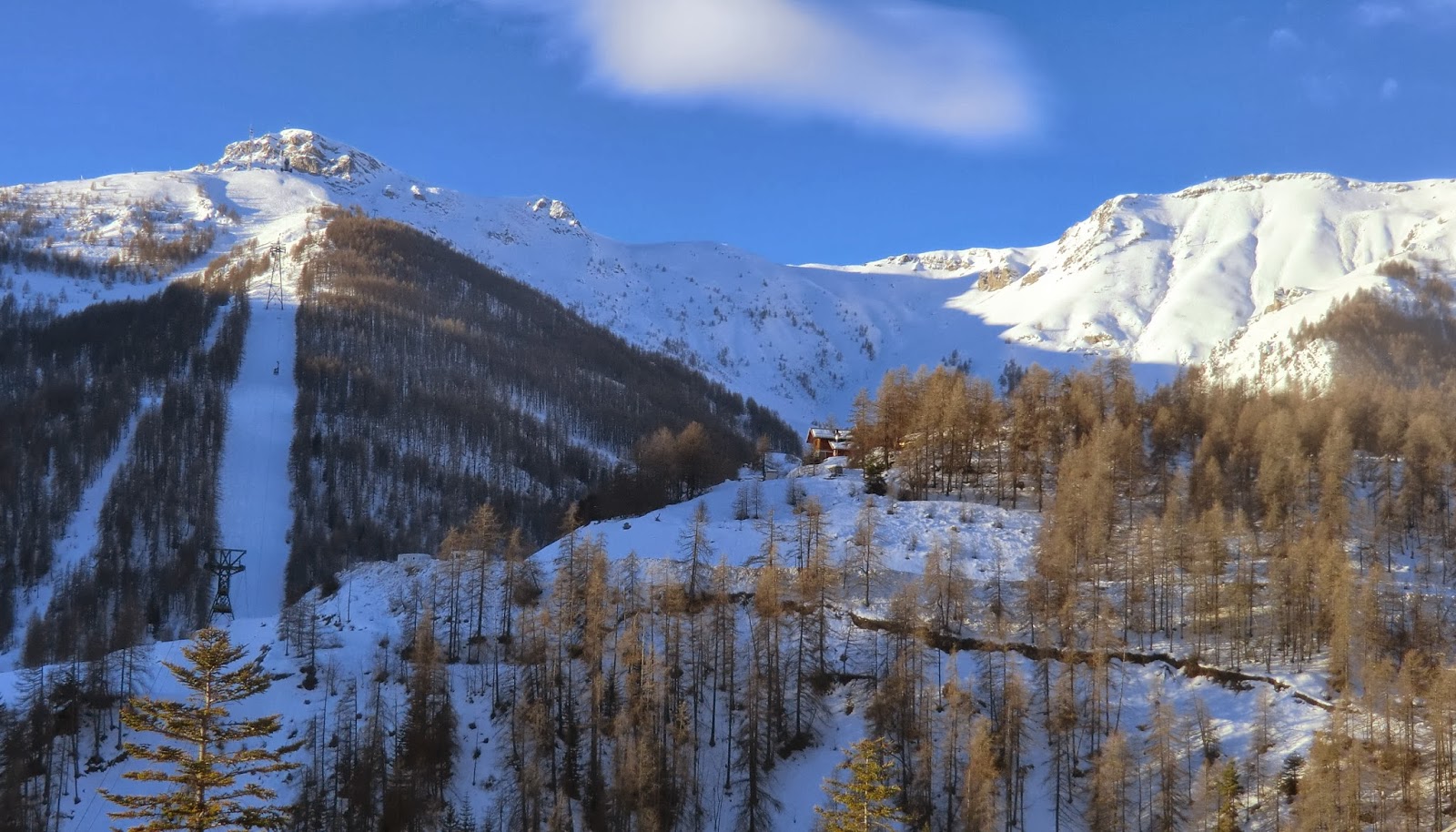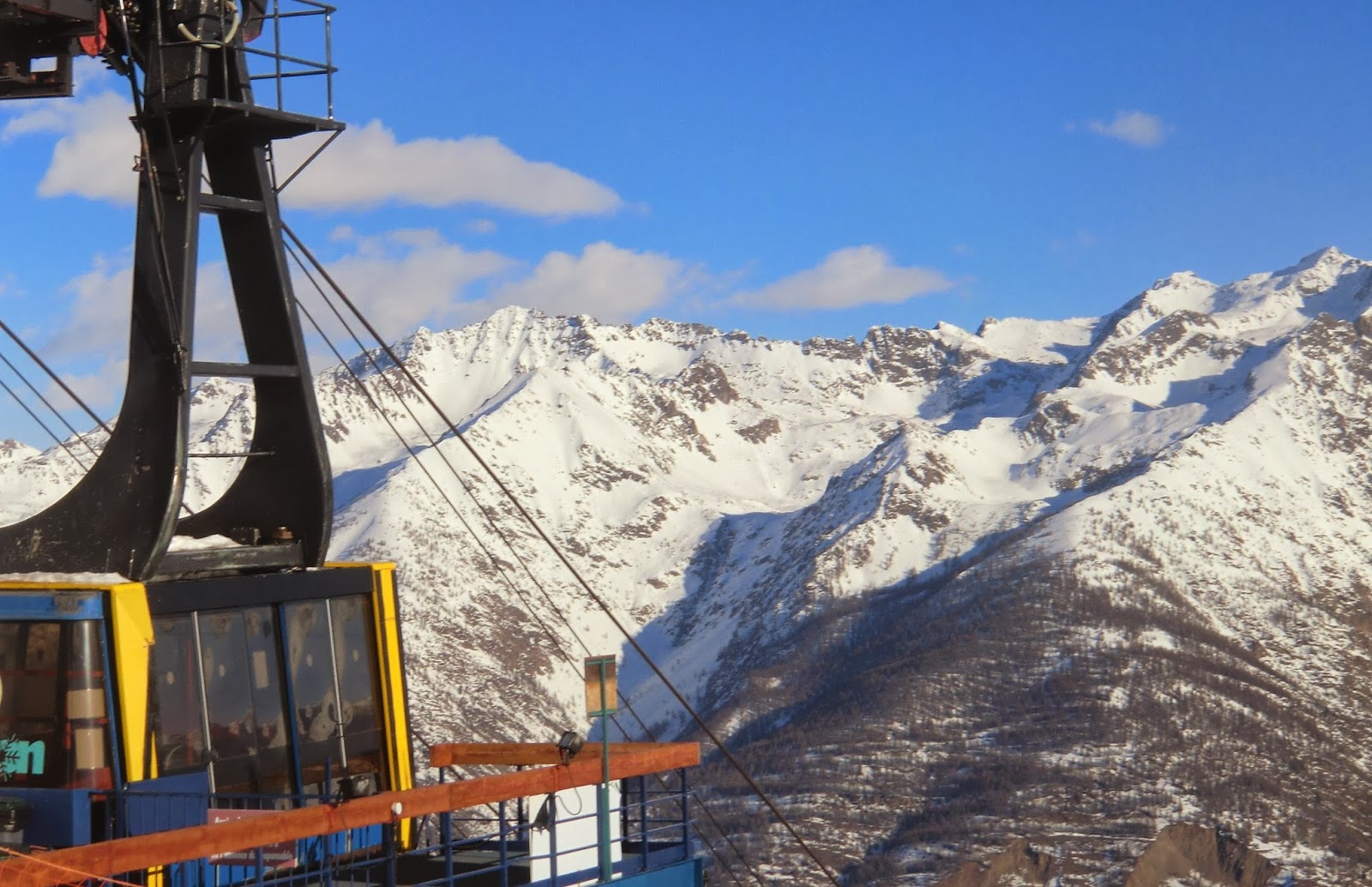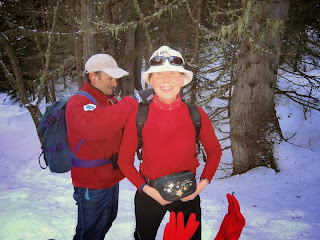
Nice-Matin recently reported of crowds never seen before in Mercantour ski resorts during the weekend after Christmas. To make things worse, Téléphérique Las Donnas in Auron was out of order one afternoon.
Traffic and parking was chaotic as many had driven up there without
snow chains or winter tyres. As we all remember, the storm called Dirk
recently brought a lot of rain to the Riviera and snow to the
mountains. The landslide on the main road just north of St Sauveur sur
Tinée did not make things easier.
Avalanche risk still 3/5
After the holiday season, January is usually a low season in French ski resorts. Even attractive package deals are offered.
Lured by a favourable weather forecast, we booked a night in Auron for the 9th of January. Traffic was light. The landslide near St Sauveur sur Tinée had been dealt with; one line was open for traffic –no delays!
According to the
Auron web site, the snow depth at
high altitude was 120 cm with 41 open ski runs. The figures do not
tell the whole truth. Having previously skied in Auron several times,
the conditions this time were one of the best we have ever seen. The weather was exceptionally mild, it
was almost like spring skiing in January, but with proper snow! The runs were well prepared.
Even
Riounet, the long descent marked as red from
Cîme de Chavalet
(2453 m) down to the
Butières chair lift, was in an excellent
condition. This sector has not any snow making facilities and has even
been closed during bad winters some years ago.
Cîme de Chavalet (2453 m), the starting point for several long runs
The resort preparing for the day. The Teleriou cable car station is visible in the lower right corner. It's just the transport between the village and the Las Donnas cable car station and the lower lifts
Las Donnas (1640-2256 m) cable car upper station.
So if you are considering skiing in Alpes Maritimes, this year seems
to be really good so far. We will certainly go back.

After the festivities many wish to lighten and simplify their eating and maybe lose a little weight. Minestrone, the Mediterranean vegetable soup, is perfect for this purpose.
There are many variations of minestrone, but they all rely on a mixture of fresh seasonal vegetables. The word minestrone describes a thick soup in general. In Italy, pancetta, Italian bacon is often added, but the meat is just as often left out. In Italy, pesto is stirred in the cooked soup whereas in Nice they add pistou. Pistou is made of crushed basil, olive oil, garlic and salt. Good pistou from Provence is sold in Nice supermarkets, the greener it is the better the taste. The richness in the soup comes from a dollop of olive oil and freshly grated parmesan which are added just before the soup is served.
In winter, in Nice supermarkets they sell packages of Italian minestrone vegetables. There are chopped cabbage, borlotti beans (I usually pick these out because they won`t be fully cooked in an hour as the other vegetables), leek, celery, lentils, Swiss chard. Most minestrone recipes include pasta or rice. I leave them out because I like to serve my minestrone with good whole wheat bread.
Any leftover soup can be frozen.
4 servings
500 g package of minestrone vegetables
1 tbsp rapeseed oil
2 shallots, chopped
2 cloves garlic, minced
400 g tin chopped tomatoes
400 g tin white beans, rinsed
700 ml vegetable stock made from 1 cube organic vegetable stock and 700 ml water
3 tsp pistou from Provence
4 tbsp olive oil
Freshly grated parmesan cheese
Warm the rapeseed oil in a heavy casserole and soften the shallots and garlic for about 10 minutes.
Add the minestrone vegetables, water, vegetable cube and tinned tomatoes and bring to a boil. Reduce the temperature and let simmer partly covered for an hour. Stir now and again.
Rinse the white beans, add to the soup and let simmer for a while so that they are heated.
When the soup is cooked, stir in the pistou.
Divide the soup in bowls. Add the parmesan and olive oil just before serving. Serve with good whole wheat bread.

In Nordic countries, in spite of the long winter, snowshoeing is not at all that common. The traditional way to more around in wintery landscapes has always been cross country skiing. Even the military moves on skis. Therefore, it was not surprising that our first snowshoeing or rando raquette experience took place here.
This winter we have unfortunately seen quite a few accidents in the Alps, many of them avalanche-related. We did the hike presented here a few years ago with guides. We recommend hiring a guide for a high terrain hike in winter even for experienced snowshoers. Local guides know their territory very well, for instance they know the areas prone to avalanches.
Le Boreon is the starting point for many trails. The route was specially chosen by our two guides. During the ascent, we even got a crash course in avalanche victim search, as shown in the video clip. The route was partly off-piste both during the ascent and descent back to Vallon de Salèse. Some parts of the tour actually followed the summer hike called “Circuit des Adus” described in the Randoxygène guide (posted recently in our blog). The summer hike, however, proceeds anticlockwise whereas the snowshoeing tour was done clockwise and started a little lower in the valley. Col de la Vallette (2356 m) was the highest point in both hikes.

Scallops, noix de saint-jacques, are usually sold removed from their shells. The edible part of the scallop is the pale muscle and orange roe (coral). They are sold either with or without the roe. I personally think that it is trickier to pan-fry the scallops with the roe. The frying time will depend on the thickness of scallops. Many French recipes recommend frying for only 1 minute, and then the pan has to be really hot. Over-cooking results in tough and rubbery scallops.
In this recipe, the scallops are decorated with grated clementine zest. Alimea Corsican clementines are 100 % organic. They are in season from October to the end of January. They are not waxed or treated after harvest so that you can safely use their zest in cooking, after washing them of course.
Because pan-frying scallops takes only 1- 1 ½ minutes on both sides and they should be served immediately, some planning is wise. It is best to prepare all the vegetables that you are going to serve on the side as well as the clementine sauce before you start frying the scallops. You might try steamed leeks, green beans or braised endives, all go very well with scallops. Serve good whole wheat bread to mop up the sauce.
2 servings
For the scallops:
6-8 fresh scallops
2- 3 tbsp rapeseed oil for frying
For the clementine sauce:
Juice of 2 Corsican clementines
Grated zest of 1 clementine
1 shallot, finely chopped
1 tbsp rapeseed oil
150 ml water
½ cube vegetable stock, preferably organic
1 tsp soya sauce
2 tsp lavender honey or other runny honey
Black pepper
Step 1: Zester the clementine
In a small saucepan, warm the rapeseed oil and soften the shallot for about 10 minutes. Add the water and the ½ cube vegetable stock and bring to a boil.
Zester one clementine and set aside the zest.
Step 2: The sauce
Press the juice of the clementines and add in the saucepan. Add the soya sauce, lavender honey and black pepper. Continue cooking and whisking occasionally until the sauce is reduced to about half. Set aside and keep warm.
Step 3: Dry the scallops
Dry the scallops with kitchen paper. The scallops I bought today are a real challenge to fry because of such a range in size, but this was what they had in our local supermarket today. I am planning to fry the large ones 1 ½ minutes on both sides and the small ones 1 minute on both sides.
Step 4: Fry the scallops
Heat the rapeseed oil in a heavy frying pan over a high heat and fry the scallops. The planned timing of frying turned out nice.
Divide the vegetables and the sauce on the plates. Place the scallops on top of the sauce and decorate with clementine zest.
































